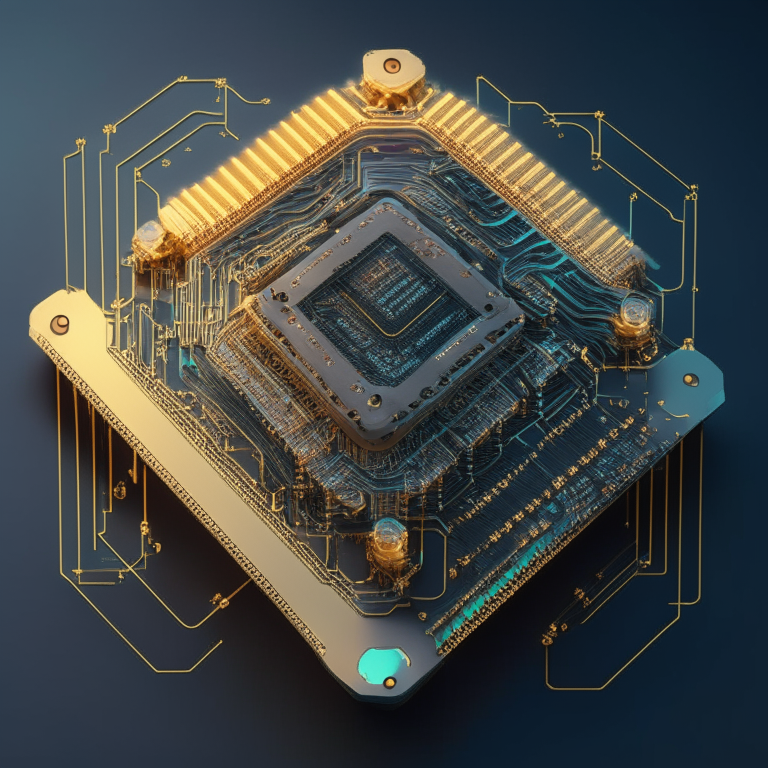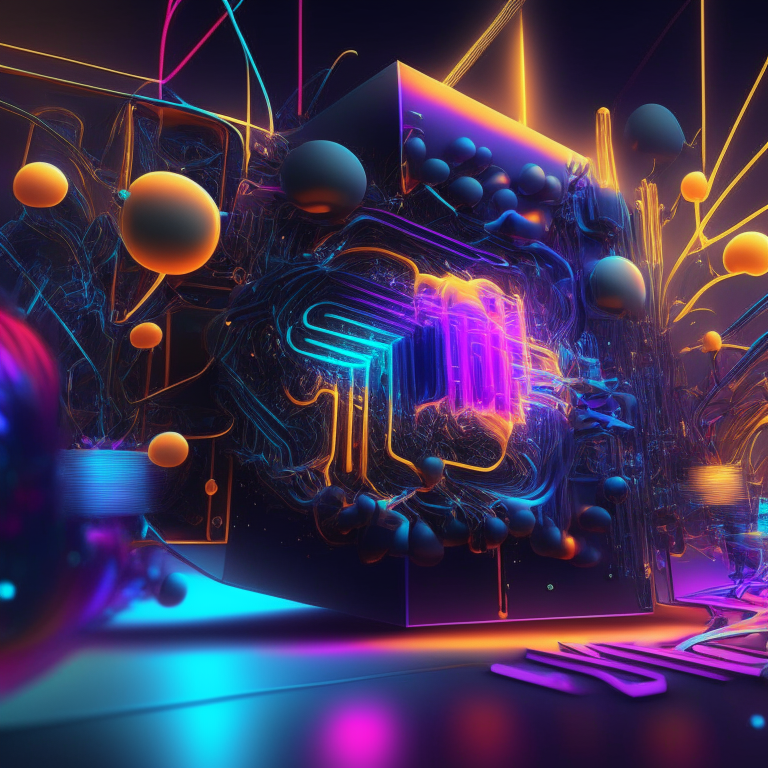Welcome to another riveting day of scientific exploration! Today, we delve into the mysterious correlation between cosmic rays and earthquakes, marvel at the audacity of AI in pushing the boundaries of CPU design, and ponder over the transformative impact of Classifier-Free Guidance on language modeling. We also explore the intriguing concept of Relay Mining for decentralized rate limiting, and finally, dive deep into the quantum world with an insightful study on Random Circuit Sampling. All this, peppered with insights from the ever-vibrant Hacker News community. So strap in, and prepare for a journey through the frontiers of scientific discovery.
Top Papers
1) Observation of large scale precursor correlations between cosmic rays and earthquakes
Summary:
A confidential manuscript uncovers a relationship between cosmic rays and earthquakes, involving authors from various institutions in Poland, Israel, Chile, and Spain.
View PDF | Chat with this paper
Copy slides outline
Copy embed code
Observation of Large-Scale Precursor Correlations between Cosmic Rays and Earthquakes
Source: arxiv.org - PDF - 9,122 words - view
Introduction
• Cosmic rays and earthquakes have a correlation
• Study involves authors from various institutions
• Confidential manuscript submission
Correlation between Cosmic Rays and Earthquakes
• Average variation of cosmic ray detection rates correlates with global seismic activity
• Time lag of approximately two weeks
• Complex and uncertain physical connection
Data Analysis on Cosmic Rays and Earthquakes
• Multiple observation sites and sources show similar patterns and trends
• Auger observatory is particularly relevant in studying the correlation
• Cross-correlation function and Fourier coefficients used for analysis
Cyclostationary Features
• Significant cyclostationary features at a cycle frequency of 0.001279 (period of 10.71 years)
• Statistical dependence and correlation between analyzed signals
• Validation with randomized data sets confirms findings
Study Findings
• Correlation between cosmic rays and earthquakes established
• Average variation of cosmic ray detection rates correlates with seismic activity
• Time lag of approximately two weeks
Importance of Understanding the Correlation
• Enhances earthquake prediction capabilities
• Provides insights into the Earth’s dynamics and cosmic ray interactions
• Potential for further research and advancements in seismology
Graph: Cosmic Ray Detection Rates vs. Seismic Activity
[Visual: Line graph illustrating the correlation between cosmic ray detection rates and seismic activity]
Graph: Cyclostationary Features Analysis
[Visual: Bar graph showing the significant cyclostationary features at a cycle frequency of 0.001279]
Auger Observatory's Role in the Study
• Auger observatory data supports correlation findings
• Importance of continued monitoring and data collection at the observatory
• Potential for future collaborations and studies using Auger observatory data
Conclusion
• Correlation between cosmic rays and earthquakes established with a time lag of approximately two weeks
• Complex and uncertain physical connection requires further research
• Auger observatory plays a significant role in understanding the correlation
Key Takeaways
• Correlation between cosmic rays and earthquakes confirmed
• Average variation of cosmic ray detection rates correlates with seismic activity
• Auger observatory provides valuable data for studying the correlation
• Further research needed to understand the complex physical connection
Hacker News:
Anomalies in the Earth’s core can impact cosmic radiation detection, and a correlation has been discovered between radiation data and the 2010 Chile earthquake. View on HN
- The magnetic properties of the Earth’s core can affect cosmic radiation detection.
- Anomalies in the Earth’s core could precede widespread global seismic activity.
- There is a correlation between cosmic radiation detection data and sunspot count.
- Cosmic rays contribute to cloud formation, raising the question of whether strange clouds can be precursors to earthquakes.
- The paper does not mention correlations between cosmic rays and Martian quakes.
- There are theories about how earthquakes chain through fault lines and the existence of earthquake lights.
- A YouTube account tracks cosmic rays and provides additional theories on earthquakes.

2) Pushing the Limits of Machine Design
Summary:
Researchers utilize AI and a Boolean Speculation Diagram to create a precise RISC-V CPU, employing a Monte Carlo-based policy for accuracy.
View PDF | Chat with this paper
Copy slides outline
Copy embed code
Pushing the Limits of Machine Design
Source: arxiv.org - PDF - 11,808 words - view
Advanced AI Techniques for Object Design
• AI enables automatic design, but machine search space is limited compared to human ability.
• Previous work focused on small objects.
• Modern AI techniques can design larger objects.
[Visual: Image showing AI designing various objects]
Automatic Design of a RISC-V CPU
• Researchers developed an AI approach for automatic CPU design.
• Boolean functions represented by Binary Decision Diagrams (BDDs).
• RISC-V CPU designed using this approach.
[Visual: Graph showing the representation of CPU design using BDDs]
Ensuring Circuit Accuracy
• Monte Carlo-based policy guarantees accuracy.
• Hierarchical expansion process boosts accuracy gradually.
• Automatically designed circuit validated through input-output examples.
[Visual: Graph showing the accuracy improvement during the hierarchical expansion process]
Reducing Complexity with Merging Operations
• Merging operations reduce the number of nodes in the Binary Speculation Diagram (BSD).
• Merging error converges to zero with more samples.
• Compact BSD representation achieved.
[Visual: Diagram showing the reduction of nodes in the BSD]
Application of Deep Learning and Explainable AI
• Deep learning techniques applied in molecular design, drug discovery, and protein structure prediction.
• Explainable AI provides insight into drug discovery.
• Efficiency and accuracy improvements achieved.
[Visual: Image showing deep learning applications in various fields]
High-Level Synthesis in Machine Design
• Machine learning used in system-level design space exploration, electronic design automation, and chip design.
• Automated CPU design involves inferring digital circuits from input-output examples.
• Challenges include accuracy and scalability.
[Visual: Diagram showing high-level synthesis in machine design]
Generating Compact Boolean Functions
• Method involves partitioning, expanding, and merging to obtain compact Boolean functions.
• Partitioning groups target Boolean functions based on similarity.
• Merging possibilities improve merging efficiency.
[Visual: Diagram showing the generation of compact Boolean functions]
Summary of Key Points
• Advanced AI techniques enable automatic design, but machine search space is limited.
• AI approach for automatic CPU design using Binary Decision Diagrams (BDDs).
• Circuit accuracy ensured through Monte Carlo-based policy and hierarchical expansion.
• Merging operations reduce complexity in the Binary Speculation Diagram (BSD).
• Deep learning and explainable AI techniques applied in various fields.
• High-level synthesis in machine design involves machine learning.
• Method for generating compact Boolean functions through partitioning, expanding, and merging.
Pushing the Limits of Machine Design
• AI techniques enable the automatic design of complex objects.
• The proposed approach pushes the limits of machine design by designing larger objects.
• Continuous advancements in AI and machine learning will further expand the possibilities of machine design.
Hacker News:
This text explores the use of AI in automated CPU design, specifically focusing on a Monte-Carlo procedure for creating a concise Boolean circuit representation, while also acknowledging skepticism from a commenter. View on HN
- The paper discusses automated CPU design using AI and presents a procedure for constructing a Boolean circuit representation based on hardware I/O test sets.
- The procedure is demonstrated using an 8-bit adder and a RISC CPU example, but does not include microarchitectural design optimizations.
- The resulting logic circuit is functional but does not consider architectural optimizations like pipelining or caches.
- The authors implemented the program on a Linux cluster with Intel Xeon Gold 6230 CPUs and verified the output netlist on FPGAs.
- The paper raises questions about the inputs and outputs of the design process, particularly for the “coarse-grained” approach.

3) Classifier-Free Guidance for Improving Language Modeling
Summary:
This document discusses the effectiveness of Classifier-Free Guidance in improving language modeling for applications such as text-to-image generation.
View PDF | Chat with this paper
Copy slides outline
Copy embed code
Improving Language Modeling with Classifier-Free Guidance
Source: arxiv.org - PDF - 17,369 words - view
Introduction
• Classifier-Free Guidance (CFG) enhances prompt-adherence in text-to-image generation and language modeling.
• CFG improves performance in Q&A, reasoning, and other tasks.
• GPT4All using CFG preferred in a blind human evaluation 75% of the time over vanilla sampling.
Enhancing Prompt-Adherence
• CFG increases the percentage of valid answer structures and model accuracy for small values.
• However, it may lead to a drop in accuracy for large values.
• Visuals: Chart comparing accuracy with and without CFG.
Boosting Performance in NLP Benchmarks
• CFG encourages tokens related to the prompt and discourages unrelated topics or regions.
• This leads to improved performance in various NLP benchmarks.
• Visuals: Examples of NLP benchmark tasks and performance improvement with CFG.
CFG in Text-to-Image Generation
• CFG has been successfully used in text-to-image generation to improve prompt-adherence.
• It upweights words related to the prompt, resulting in better image generation.
• Visuals: Examples of text-to-image generation with and without CFG.
CFG's Impact on Sampling Entropy
• CFG reduces the entropy of the logit distribution, resulting in a lower CFG entropy distribution compared to vanilla prompting.
• The top tokens do not shift significantly with CFG.
• Visuals: Graph illustrating the entropy distribution with and without CFG.
Conclusion
• CFG is a powerful technique for improving language modeling.
• It enhances prompt-adherence, boosts performance in various tasks, and improves NLP benchmark results.
• Reminder: CFG encourages tokens related to the prompt and discourages unrelated topics or regions.
Key Takeaways
• Classifier-Free Guidance (CFG) improves prompt-adherence in language modeling.
• CFG enhances performance in Q&A, reasoning, and other tasks.
• GPT4All using CFG was preferred in a blind human evaluation 75% of the time.
• CFG encourages tokens related to the prompt and discourages unrelated topics or regions, leading to improved performance in NLP benchmarks.
Hacker News:
The implementation of Classifier Free Guidance on GitHub improves LLM performance and benefits the diffusion community. View on HN
- “Classifier Free Guidance” works on LLMs with a significant boost in performance.
- The implementation code for “Classifier Free Guidance” may be released in the future.
- Stability and Coreweave provided funding for the compute required for “Classifier Free Guidance.”
- Advancements in the diffusion community may impact the local llama scene in the near future.
- The implementation of “Classifier Free Guidance” may involve a one-line change.
- There is a question about what “Classifier Free Guidance” and logits mean.
- There is a desire for faster implementation of various NLP techniques.
- “Classifier Free Guidance” is compared to a balanced audio cable in multiple dimensions.

4) Relay Mining Verifiable Multi-Tenant Distributed Rate Limiting
Summary:
Relay Mining allows decentralized rate limiting with probabilistic mechanisms and incentives, ensuring both reliability and performance.
View PDF | Chat with this paper
Copy slides outline
Copy embed code
Relay Mining: Decentralized Multi-Tenant Rate Limiting
Source: arxiv.org - PDF - 6,712 words - view
Introduction
• Relay Mining enables decentralized rate limiting with probabilistic mechanisms and incentives.
• It allows multiple RPC service providers to handle network traffic from individual applications.
• Costs, rewards, and fairness are ensured through crypto-economic incentives.
Problem Statement
• Trade-offs between Reliability and Performance must be addressed in rate limiting.
• Inefficiency and security concerns arise from the majority of each block being composed of Merkle Proofs.
• Permissionless addition of new Applications and Services is not possible due to state bloat.
Token Bucket Rate Limiting
• Rate limiting algorithms can be categorized as Token Bucket.
• Token Bucket algorithm helps control the rate of data flow.
• It ensures that the number of requests from an application does not exceed a certain limit.
Fair and Permissionless Distribution
• Relay Mining ensures fair distribution of work between applications and servicers.
• Additional communication between servicers is not required.
• Incentive-driven rate limiting is achieved through data stored on a distributed ledger.
Random Branch Request
• In Relay Mining, a random branch must be requested since the tree is incomplete.
• A random set of bits is generated using on-chain data.
• The closest membership proof for an unknown set of leaves is found.
Efficient Handling of RPC Requests
• Relay Mining efficiently handles a large number of RPC requests in decentralized networks.
• It leverages crypto-economic incentives to enable multi-tenant rate limiting.
• Byzantine actors can be accounted for in the algorithm.
References
• Various sources related to relay mining and verifiable multi-tenant distributed rate limiting are referenced.
• ethereum.org discusses maximal extractable value (MEV).
• Fabio Wehb Ferrari mentions Ankr becoming
Protocol Actors
• The document discusses the interaction and responsibilities of various protocol actors in the Pocket Network.
• Actors include Validators, Servicers, Watchers, Applications, and Portals.
• Applications pay for access to RPC services, while Servicers handle the network traffic.
Conclusion
• Relay Mining offers a decentralized solution for multi-tenant rate limiting.
• It leverages probabilistic mechanisms and incentives to ensure fairness and performance.
• By efficiently handling a large number of RPC requests, it addresses the needs of decentralized networks.
Hacker News:
The blockchain paper “Relay Mining: Verifiable Multi-Tenant Distributed Rate Limiting” has remained on the front page of Hacker News without any comments, surprising some users who question the lack of attention, while others argue that the treatment of blockchain in this context is rational. View on HN
- Relay Mining is a verifiable multi-tenant distributed rate limiting system.
- The paper discussing Relay Mining has remained on the front page of Hacker News for a significant amount of time.
- There is surprise over a blockchain paper receiving such attention and traction.
- Some users question the irrational hatred towards blockchain technology.
- One user suggests treating blockchain for what it is without any irrational biases.

5) Phase transition in Random Circuit Sampling
Summary:
Google Quantum AI and its collaborators conducted a study on Random Circuit Sampling (RCS), identifying phase boundaries through cross-entropy benchmarking to observe distinct phases influenced by the interaction of quantum dynamics and noise.
View PDF | Chat with this paper
Copy slides outline
Copy embed code
Exploring Phase Transition in Random Circuit Sampling
Source: arxiv.org - PDF - 31,002 words - view
Introduction
• Google Quantum AI and collaborators conducted experiments on Random Circuit Sampling (RCS) to study the interplay between quantum dynamics and noise.
• They observed distinct phases driven by this interplay and identified phase boundaries using cross-entropy benchmarking.
• The study aims to characterize quantum supremacy in near-term devices.
Noise-Induced Phase Transition
• A noise-induced phase transition was observed in a 2D random circuit sampling experiment.
• The order parameter increased with increasing depth for noise rates below 0.17, but decreased for noise rates above 0.17.
• The critical point of the transition was determined.
Computational Hardness of RCS
• The study presents a new RCS experiment, demonstrating the computational hardness and memory requirements of the process.
• The XEB fidelity was estimated using a discrete gate set and sampling circuit instances.
• The results show a sharp transition to maximum computational hardness.
Quantum Computational Advantage
• Platt et al. (2019) and Wu et al. (2021) demonstrated quantum computational advantage with superconducting processors.
• These studies are relevant to the phase transition in Random Circuit Sampling.
• The interplay between quantum dynamics and noise plays a crucial role in achieving computational advantage.
Distinction from Quantum to Classical Transition
• The phase transition in Random Circuit Sampling is different from the quantum to classical transition discussed in a previous reference.
• It is a competition between the convergence rate to the overall ergodic state and the fidelity per cycle.
• The authors validate quantum supremacy experiments using tensor network contraction.
Benchmarking and Characterization
• The document discusses the benchmarking of a random circuit sampling device and presents an ISWAP-like characterization.
• Error rates, echo times, and XEB fidelity were measured to validate the error model.
• The characterization helps in understanding the behavior of RCS devices.
Unveiling the Phases in Random Circuit Sampling
• Random Circuit Sampling exhibits distinct phases influenced by the interplay between quantum dynamics and noise.
• The identification of phase boundaries through cross-entropy benchmarking provides valuable insights.
• Understanding these phases is crucial for characterizing quantum supremacy in near-term devices.





